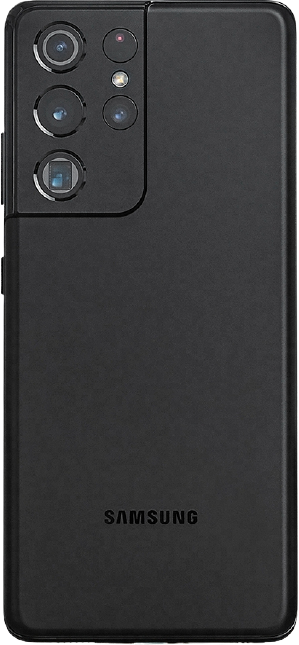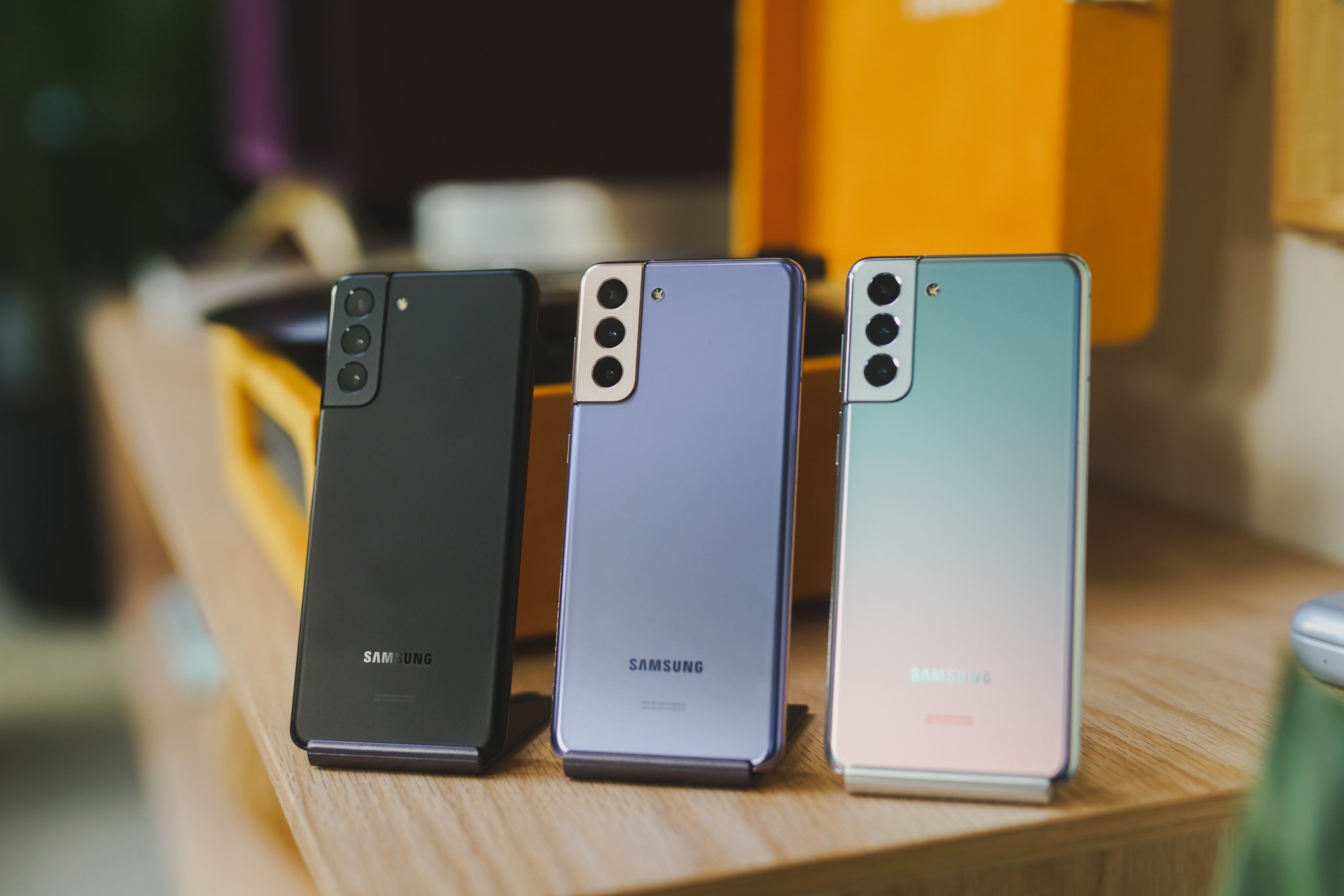Samsung Galaxy S21
A bold new direction
Pros
- Stunning 120Hz AMOLED display
- Snapdragon 888 with Sub-6/mmWave 5G
- Reliable cameras
- Three years of guaranteed updates
- 15W wireless charging and IP68
Cons
- No microSD card slot
- No charger in the box
- Plastic back
The Galaxy S21 offers the latest hardware from Qualcomm along with a sublime 120Hz AMOLED screen, cameras that take great photos in any lighting scenario, and global 5G connectivity. You'll still find all the extras, but the phone misses out on a microSD slot this year and there's no charger in the box.
Google Pixel 5
Still the camera king
Pros
- Gorgeous 90Hz OLED panel
- Snapdragon 765G with Sub-6/mmWave 5G
- Incredible cameras with a wide-angle lens
- Three Android version updates
- 15W wireless charging and IP68
Cons
- Not running Snapdragon 800 series
- Limited global availability
The Pixel 5 is unchallenged when it comes to the camera, with the phone delivering truly outstanding photos. You also get a feature-rich package that includes a 90Hz OLED screen, wireless and reverse wireless charging, and Sub-6 as well as mmWave 5G. Despite its shortcoming compared to the Galaxy S21, you're overall getting a great value.
The Galaxy S21 is here, and it brings hardware refinements as well as a lower price tag that sees it go up directly against Google's 2020 flagship, the Pixel 5. Both phones have a lot of similarities and offer a similar value, so let's take a look at where they stand and what phone you should pick up if you're interested in a flagship in 2021.
Galaxy S21 vs. Pixel 5 Two flagships with the same identity
On the surface, the Galaxy S21 packs incremental upgrades. The biggest change is that it's powered by Qualcomm's new 5nm Snapdragon 888 platform, unlocking a new level of performance. There's also a fresh new design at the back for the cameras, but otherwise, you are getting a device that hasn't changed too much from its predecessor.
The Galaxy S21 and Pixel 5 deliver the features you want at an attractive price point.
As for the Pixel 5, Google went with the mid-range Snapdragon 765G to keep costs low. That has allowed Google to launch the phone for just $700 while making sure that it didn't miss out on any of the extras. The strategy was a smart one, with the Pixel 5 undercutting its rivals and becoming one of the best Android phones available today.
Samsung, in fact, took a leaf out of Google's playbook with the Galaxy S21. The phone has a few downgrades when seen against last year's Galaxy S20 — the S21 has a plastic back, and the screen resolution has been lowered to FHD+ from QHD+. Samsung also got rid of the charger and earbuds from the Galaxy S21's packaging to further cut down on costs, but the end result is that the phone retails for $800, $200 less than its predecessor.
The Galaxy S21 stands out a little bit more in terms of the design thanks to the new camera housing at the back that's made out of metal. That said, the back panel itself is plastic and not glass, and the phone is still somehow 19g heavier than the Pixel 5 even though it has the same 4,000mAh battery.
I'm a fan of Google's minimalist design aesthetic, and like what the Pixel 5 has to offer. The metal back has a plastic cutout for the wireless charging coil, but the overall design, as well as that Sorta Sage color option, gives the Pixel 5 a slight edge in this area.
As for the screen, the Galaxy S21 has a 6.2-inch AMOLED panel, with the Pixel 5 rocking a 6.0-inch OLED screen. The S21 wins out thanks to its 120Hz refresh rate tech, with the Pixel 5 at 90Hz. Both screens have the same FHD+ (2400x1080) resolution and deliver HDR10+ content in Netflix and other streaming services. You also get stereo speakers as standard across both phones.
Switching over to the internal hardware, the Galaxy S21 has the obvious edge thanks to the Snapdragon 888. Google went with the Snapdragon 765G, and while the chipset has a lot to offer, it doesn't quite measure up to the Snapdragon 888. Having said that, you don't really notice any shortcomings with the Pixel 5 in day-to-day use, with the phone holding up just fine for scrolling through social media or gaming.
Both phones have Sub-6 and mmWave 5G, IP68, and wireless charging.
Both phones have Sub-6 and mmWave 5G as standard, which is a move in the right direction as 5G becomes more mainstream. You don't miss out on any of the extras either; both the Pixel 5 and Galaxy S21 have IP68 dust and water resistance, 15W wireless charging, and reverse wireless charging out of the box. Both phones also have 8GB of RAM with 128GB of storage for the base models.
Both phones have all-day battery life, and the Galaxy S21 has 25W fast charging while the Pixel 5 relying on 18W USB PD wired charging. Samsung doesn't include a charger or earbuds in the box, but the Pixel 5 doesn't include earbuds either, although it does throw in an 18W USB PD charger and a USB-C to USB-C cable.
Now, an interesting omission with the Galaxy S21 is the microSD slot. Samsung ditched the port with this year's flagships, and if you relied on a microSD slot on your previous Galaxy phone, we've rounded up the best microSD alternatives for the Galaxy S21.
Coming to the camera side of things, the Galaxy S21 has a 12MP f/1.8 lens that's unchanged from last year, and it also has a 12MP wide-angle module and 64MP 23x zoom lens. The Pixel 5, meanwhile, has a 12.2MP f/1.7 lens that is basically the same module from the Pixel 2, and this time it is packing a new 16MP wide-angle lens.
Google built its Pixel brand around delivering the best camera on a phone, and that continues to be the case with the Pixel 5. The phone takes gorgeous photos in any lighting scenario, but its low-light prowess gives it a distinct edge over other flagships.
Galaxy S21 vs. Pixel 5 These are the full specs
| Category | Galaxy S21 | Pixel 5 |
|---|---|---|
| Operating system | Android 11 One UI 3.1 |
Android 11 |
| Display | 6.2-inch 120Hz Dynamic AMOLED 2400x1080 (20:9) HDR10+ Gorilla Glass Victus |
6.0-inch 90Hz OLED 2340x1080 (19.5:9) HDR10+ Gorilla Glass 6 |
| Chipset | Snapdragon 888 1 x 2.84GHz X1 3 x 2.42GHz A78 4 x 1.80GHz A55 Adreno 660 5nm |
Snapdragon 765G 1 x 2.4GHz A76 1 x 2.2GHz A76 6 x 1.8GHz A55 Adreno 620 7nm |
| RAM | 8GB LPDDR5 | 8GB LPDDR4X |
| Storage | 128GB/256GB UFS3.1 | 128GB |
| MicroSD slot | ❌ | ❌ |
| Rear camera 1 | 12MP f/1.8, OIS 8K at 30fps 4K at 60fps |
12.2MP, f/1.7 4K at 60fps |
| Rear camera 2 | 12MP, f/2.2 wide-angle |
16MP, f/2.2 107-degree wide-angle lens |
| Rear camera 3 | 64MP, f/3.0 telephoto, OIS 3x optical zoom |
❌ |
| Front camera | 10MP f/1.7 auto focus |
8MP, f/2.0 |
| Connectivity | 5G (Sub-6 and mmWave) Wi-Fi 6 MU-MIMO Bluetooth 5.0 LE, NFC, GPS |
5G (Sub-6 and mmWave) Wi-Fi ac Bluetooth 5.0 NFC, A-GPS |
| Audio | USB-C Stereo speakers |
USB-C Stereo speakers |
| Battery | 4000mAh Non-removable |
4080mAh Non-removable |
| Charging | USB-C PD 3.0 Fast charge (25W) Wireless charging |
18W USB-C 3.1 15W wireless charging 5W reverse wireless charging |
| Water resistance | IP68 | IP68 |
| Security | In-display fingerprint sensor | Rear fingerprint sensor |
| Dimensions | 151.7 x 71.2 x 7.9mm 172g |
144.7 x 70.4 x 8mm 151g |
| Colors | Phantom Gray, Phantom White, Phantom Violet, Phantom Pink | Just Black, Sorta Sage |
Galaxy S21 vs. Pixel 5 You can't go wrong here
There really isn't that much to differentiate the Galaxy S21 from the Pixel 5. Samsung's decision to downgrade the hardware in a few areas to bring the asking price down to $800 should move the needle favorably for the Galaxy S21, but that doesn't impact the overall quality of the phone.
Right now, these are the two best options if you want a flagship for under $1,000.
The Galaxy S21 has the latest Qualcomm silicon along with Sub-6 and mmWave 5G, an FHD+ 120Hz AMOLED panel that is one of the best in the industry, cameras that take great photos in any lighting condition, and all the extras you could ask for. The fact that the phone runs Android 11 out of the box and is guaranteed to receive three Android updates means it is on an equal footing with the Pixel 5 in this regard.
So if you are looking for a flagship for around the $800 figure, the Galaxy S21 is a great choice. That said, the Pixel 5 isn't far behind either. At $700, it's that much more affordable than the S21, and while the Snapdragon 765G doesn't measure up to the Snapdragon 888, it is more than adequate for most day-to-day and gaming use cases.
The Pixel 5 has a better camera, and the addition of a wide-angle lens at the back makes it a much more versatile shooter. I prefer Google's software, and the Pixel 5 will receive updates faster. The 90Hz OLED panel is just as vibrant as what you're getting with Samsung, you get Sub-6 and mmWave 5G with the Pixel 5 as well, and the phone has IP68 resistance, 15W wireless charging, and reverse wireless charging as well.
So you're not really missing out on any features on the Pixel 5, and for my money, I'd go with Google's 2020 flagship in spite of the fact that it is running a chipset that's not as powerful as the Galaxy S21.
Samsung Galaxy S21
A bold new direction
$800 at Amazon $800 at Samsung
All the features you want
The Galaxy S21 features Qualcomm's latest silicon, delivering blistering performance. The hardware is some of the best in this category, including a 120Hz AMOLED screen, Sub-6 and mmWave 5G connectivity, great cameras, and IP68 along with wireless charging. If you're upgrading from an older Galaxy phone, the S21 has plenty to offer.
Google Pixel 5
Still the camera king
Hitting all the right notes
The Pixel 5 delivers enticing hardware in a gorgeous design that doesn't miss out on any of the extras. You get a vibrant OLED screen with a 90Hz refresh rate, Sub-6 and mmWave 5G, 8GB of RAM, IP68 water resistance, and wireless charging. The best part is the cameras on offer, with Google carving out a lead over just about everyone else.
from Android Central - Android Forums, News, Reviews, Help and Android Wallpapers https://ift.tt/2MqYfhm
via IFTTT



Aucun commentaire:
Enregistrer un commentaire